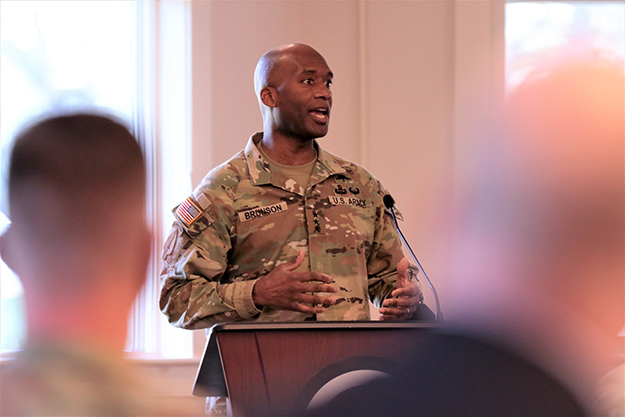JOINT BASE LEWIS-MCCHORD - Gen. Andrew Poppas, the U.S. Army Forces Command (FORSCOM) Commanding General, joined Lt. Gen. Xavier Brunson and Command Sgt. Maj. Nema Mobar, America's First Corps command team, along with commanders and senior enlisted leaders across I Corps for a two-day Fall Commander's Conference September 4-5, 2024, at the Washington National Guard Center on Joint Base Lewis-McChord.
The conference's purpose was for command teams to discuss current events and the history of I Corps in the Indo-Pacific theater and a wide range of topics dedicated to significantly improving the lives of service members, interoperability, team-building and readiness.
Poppas emphasized that modernization should focus on three levels: structural changes, equipment and training. He also highlighted the importance of elevating training in order to refine processes, capabilities and warfighting readiness.
"We must focus on the scale and scope of conflict in today's global landscape, which has expanded since the Global War on Terrorism," said Poppas. "We need to reinforce the need for multi-domain interoperability and understand where capability gaps exist."
Brunson also stressed the importance of consolidating gains, taking lessons learned, and ensuring readiness across formations.
"Readiness equates to lethality," Brunson stated. "We must communicate that to soldiers clearly and effectively."
Brunson also called for innovative engagement strategies, focusing on solving operational problems by applying lessons from 2023-2024, which reinforces the importance of governance process transformation and aligning with the Army of 2030 and 2040 goals.
"We must serve as a model for partners, leveraging relationships with forward elements like Special Operations Forces (SOF) and Security Force Assistance Brigades (SFABs)," Brunson said. "Interoperability is so vital in this region to sustain a presence."
The spouses of the senior leaders also had an opportunity to visit the child care facilities on the installation and learn more about the resources available to soldiers and their families. Senior leader spouses are generally the lead for the Soldier Family and Readiness Groups (SFRG), and can assist other spouses with resources and information regarding the installation and deployment information. The SFRG acts as a liaison between Army families and soldier's command teams, by providing information for deployments, missions, and general Army tasks and missions.
On the last day of the conference, the senior leaders conducted a physical training session led by the 42nd Military Police Brigade's Holistic Health and Fitness (H2F) professionals, which focused on strength, endurance, and mental resiliency. The command teams were paired up to conduct exercises and mental games, like crossword puzzles with names of Medal of Honor recipients while holding a plank, stacking bolts using only a small stick and strength and endurance exercises. The command teams worked together, alternating through different events and exercises, to win the competition and build esprit de corps.
"Team building is important and can be created by spending time together and ensuring leaders are present and engaged with their soldiers," Poppas said.
The conference follows the latest Spring Commander's conference in which the I Corps command teams discussed H2F implementation across the Corps and how to effectively communicate with others across the Indo-Pacific theater.





Read Comments